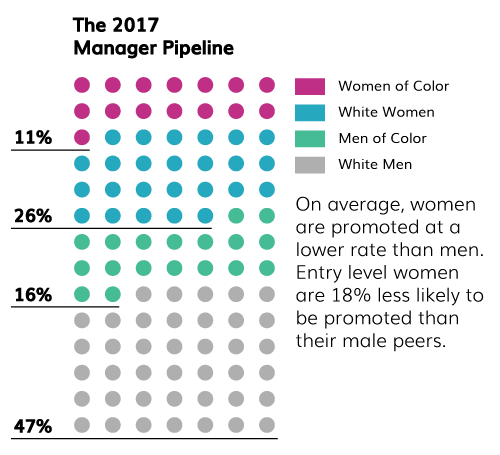
It’s no secret most companies are facing a leadership crisis when it comes to female leadership. We see it in companies of all sizes and in every industry. A McKinsey & Company study shows that women remain significantly underrepresented in the corporate pipeline.
The Glass Ceiling is Lower Than We Think
For years, many were led to believe cracking the code of the glass ceiling started at senior-level and c-suite positions. We now know based on current research it begins earlier in one’s career before most women even recognize they fall prey to falling behind. At the first critical step up to manager, women are 18 percent less likely to be promoted than their male peers.
The representation of women declines at every crucial step. And yet it has very little to do with lack of interest or career fatigue. The research is clear, both men and women ask for promotions at similar rates.

The result?
Women’s participation in the workforce drops from 46 percent to a mere 29 percent by the time they reach VP status. If entry-level women were promoted at the same rate as their male peers, the number of women at the SVP and C-suite levels would more than double.
So what?
The loss isn’t just for women and their career advancement. Companies risk the cost of lower revenues and lack of innovation.
The same McKinsey study recently found that companies in the top quartile for gender diversity are 15 percent more likely to have financial returns above their respective industry medians.
Additionally, Catalyst determined companies with the most women on the board of directors had 16 percent higher return on sales than those with the least.
What now?
Here are five ways we can rise above this glass ceiling challenge. I’ve crafted these practical tips based on my extensive experience as the first female EVP at Walmart, Inc. that you can use to drive real change for women to achieve their full potential within your organization.
Rethink how we identify potential.
One contributing factor to the glass ceiling effect is that men are promoted on the basis of potential and women are promoted on the basis of delivered results, as captured in studies by McKinsey and by Catalyst.org and in Sheryl Sandberg’s research in her book, Lean In: Women, Work, and the Will to Lead. Therefore, women and men should be assigned stretch assignments at equal rates.
Next, we must find a more objective way to identify potential. It cannot be an instinct or a judgment call. It needs to be based on observable behaviors that can predict potential.
We used leadership competencies at Walmart in our talent review, talent development, and performance evaluation processes. Competencies such as intellectual curiosity, drive for results, synthesizing strategic choices, managing diverse relationships, building talent pipelines, innovation management, and strategic and organizational agility were critical priorities based upon the growth and critical skills required to lead in a dynamic marketplace.
And last, in this category, we must build talent pipelines and succession plans that have equal representation of high-potential women and men.
Focus on career sponsorship.
One factor in women’s lower rate of promotion is that they are less likely to receive advice from managers and senior leaders on how to advance. This kind of support is important: employees who receive it are more likely to say they’ve been promoted in the last two years.
It’s important to note that a sponsor is very different from a mentor. A mentor provides advice and support, but a sponsor uses his or her organizational influence to advocate for individuals when making stretch-assignment decisions and promotion decisions.
Sponsor relationships take time to develop; sponsorship comes to those the leader knows well. And high-potential talent should work to build sponsor relationships with both men and women.
Increase the representation of women and diverse talent in “feeder” positions for senior executive roles and potential board roles.
This is all about building diverse talent-succession pipelines for the most critical positions identified in your organizations.
At Walmart, we called them the ‘Top Fifty Critical Roles,’ and we reviewed the talent identified for these positions at least twice a year. For smaller organizations, you might consider identifying the top five to 10 influential roles and how you can place more women into the ‘feeder pipeline’ of each.
We also developed individualized development plans for leaders in the pipeline to ensure readiness for promotion when positions were open. Ensuring a diverse pipeline is required to achieve talent readiness when opportunities become available.
Identify the P&L gap in your organization.
Providing women and diverse talent experience in P&L (profit and loss) roles is a critical component to preparing them for senior-executive positions.
I have shared this sage advice with so many high-potential individuals. It will be hard to get to the top of your organization if you have not demonstrated success when leading a P&L. Take the opportunity when it is presented!
One of the best pieces of advice I ever received was from David Glass, former CEO of Walmart, Inc., when I was offered a P&L role at Sam’s Club. I was on a career track to succeed the chief human resources (we called it people) executive. When presented with the opportunity to lead a large P&L, Mr. Glass’s advice was, “Go for it! You can always get back into the People Division later in your career.”
CEO involvement and transformational inclusion and “unconscious bias” programs.
These programs must be driven from the top and be paired with persistence and management commitment. I cannot stress the importance of CEO involvement. It is all about tone at the top. When the CEO identifies inclusion and diversity as a top priority, they get implemented.
The key differentiator is the CEO holding their direct reports and all management levels accountable for their behaviors and results. This requires adherence by inspecting talent pipelines and talent promotions and by identifying the critical behaviors expected from the senior leaders. When ongoing adherence occurs, a company can move from implementation to true culture integration.
—
All of these actions can be distilled down to three concepts – placing women in big jobs, supporting women and recognizing and dismantling unconscious bias.
Companies and bosses aren’t going to change overnight. In fact, change starts with you! It starts with you and your willingness to navigate a workplace that is getting increasingly more dynamic. There are very real barriers to making real progress for women in the workplace. And I want to face those barriers with real answers.
My generation made the business case for equality – but there’s work to do. Real and sustainable progress is going to require much more. The next generations have to have the courage to pick up where we left off.
Lastly, I must give credit to the Network of Executive Women who discovered most of these fundamental ideas through their research. If you are not familiar with NEW, please connect with them at newonline.org. I find their conclusions in this research to be on the mark!
—
Want to dive deeper on this topic?
You can learn more about how to drive real change for women at work through my book, Gracious and Strong.

